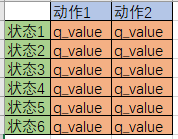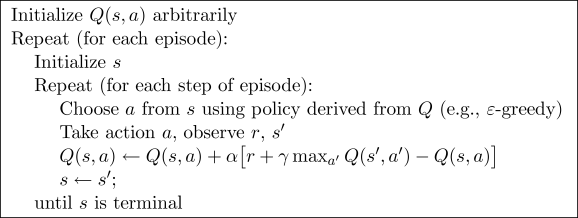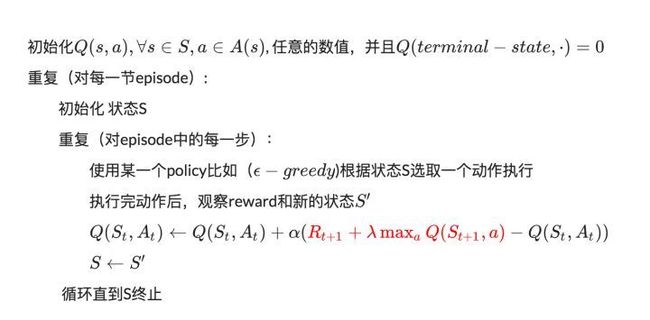本文作者:hhh5460
本文地址:https://www.cnblogs.com/hhh5460/p/10134018.html
问题情境
-o---T
# T 就是宝藏的位置, o 是探索者的位置
这一次我们会用 q-learning 的方法实现一个小例子,例子的环境是一个一维世界,在世界的右边有宝藏,探索者只要得到宝藏尝到了甜头,然后以后就记住了得到宝藏的方法,这就是他用强化学习所学习到的行为。
Q-learning 是一种记录行为值 (Q value) 的方法,每种在一定状态的行为都会有一个值 Q(s, a),就是说 行为 a 在 s 状态的值是 Q(s, a)。s 在上面的探索者游戏中,就是 o 所在的地点了。而每一个地点探索者都能做出两个行为 left/right,这就是探索者的所有可行的 a 啦。
致谢:上面三段文字来自这里:https://morvanzhou.github.io/tutorials/machine-learning/reinforcement-learning/2-1-general-rl/
要解决这个问题,下面的几个事情要先搞清楚:
0.相关参数
epsilon = 0.9 # 贪婪度 greedy alpha = 0.1 # 学习率 gamma = 0.8 # 奖励递减值
1.状态集
探索者的状态,即其可到达的位置,有6个。所以定义
states = range(6) # 状态集,从0到5
那么,在某个状态下执行某个动作之后,到达的下一个状态如何确定呢?
def get_next_state(state, action): '''对状态执行动作后,得到下一状态''' global states # left, right = -1,+1 # 一般来说是这样,不过要考虑首尾两个位置 if action == 'right' and state != states[-1]: # 除最后一个状态(位置),皆可向右(+1) next_state = state + 1 elif action == 'left' and state != states[0]: # 除最前一个状态(位置),皆可向左(-1) next_state = state -1 else: next_state = state return next_state
2.动作集
探索者处于每个状态时,可行的动作,只有"左"或"右"2个。所以定义
actions = ['left', 'right'] # 动作集。也可添加动作'none',表示停留
那么,在某个给定的状态(位置),其所有的合法动作如何确定呢?
def get_valid_actions(state): '''取当前状态下的合法动作集合,与rewards无关!''' global actions # ['left', 'right'] valid_actions = set(actions) if state == states[-1]: # 最后一个状态(位置),则 valid_actions -= set(['right']) # 去掉向右的动作 if state == states[0]: # 最前一个状态(位置),则 valid_actions -= set(['left']) # 去掉向左 return list(valid_actions)
3.奖励集
探索者到达每个状态(位置)时,要有奖励。所以定义
rewards = [0,0,0,0,0,1] # 奖励集。只有最后的宝藏所在位置才有奖励1,其他皆为0
显然,取得状态state下的奖励就很简单了:rewards[state] 。根据state,按图索骥即可,无需额外定义一个函数。
4.Q table
最重要。Q table是一种记录状态-行为值 (Q value) 的表。常见的q-table都是二维的,基本长下面这样:
所以定义
q_table = pd.DataFrame(data=[[0 for _ in actions] for _ in states], index=states, columns=actions)
5.环境及其更新
考虑环境的目的,是让人们能通过屏幕观察到探索者的探索过程,仅此而已。
环境环境很简单,就是一串字符 '-----T'!探索者到达状态(位置)时,将该位置的字符替换成'o'即可,最后重新打印整个字符串!所以
def update_env(state): '''更新环境,并打印''' global states env = list('-----T') if state != states[-1]: env[state] = 'o' print('\r{}'.format(''.join(env)), end='') time.sleep(0.1)
6.最后,Q-learning算法
Q-learning算法的伪代码
中文版的伪代码:
图片来源:https://www.hhyz.me/2018/08/05/2018-08-05-RL/
Q value的更新是根据贝尔曼方程:
$$Q(s_t,a_t) \leftarrow Q(s_t,a_t) + \alpha[r_{t+1} + \lambda \max _{a} Q(s_{t+1}, a) - Q(s_t,a_t)] \tag {1}$$
好吧,是时候实现它了:
# 总共探索13次 for i in range(13): # 0.从最左边的位置开始(不是必要的) current_state = 0 #current_state = random.choice(states) # 亦可随机 while current_state != states[-1]: # 1.取当前状态下的合法动作中,随机(或贪婪)地选一个作为 当前动作 if (random.uniform(0,1) > epsilon) or ((q_table.ix[current_state] == 0).all()): # 探索 current_action = random.choice(get_valid_actions(current_state)) else: current_action = q_table.ix[current_state].idxmax() # 利用(贪婪) # 2.执行当前动作,得到下一个状态(位置) next_state = get_next_state(current_state, current_action) # 3.取下一个状态所有的Q value,待取其最大值 next_state_q_values = q_table.ix[next_state, get_valid_actions(next_state)] # 4.根据贝尔曼方程,更新 Q table 中当前状态-动作对应的 Q value q_table.ix[current_state, current_action] += alpha * (rewards[next_state] + gamma * next_state_q_values.max() - q_table.ix[current_state, current_action]) # 5.进入下一个状态(位置) current_state = next_state print('\nq_table:') print(q_table)
好了,这就是大名鼎鼎的Q-learning算法!
注意,贝尔曼方程中,取奖励是用了 rewards[next_state],再强调一下:next_state
当然,我们希望能看到探索者的探索过程,那就随时更新(打印)环境即可:
for i in range(13): #current_state = random.choice(states) current_state = 0 update_env(current_state) # 环境相关 total_steps = 0 # 环境相关 while current_state != states[-1]: if (random.uniform(0,1) > epsilon) or ((q_table.ix[current_state] == 0).all()): # 探索 current_action = random.choice(get_valid_actions(current_state)) else: current_action = q_table.ix[current_state].idxmax() # 利用(贪婪) next_state = get_next_state(current_state, current_action) next_state_q_values = q_table.ix[next_state, get_valid_actions(next_state)] q_table.ix[current_state, current_action] += alpha * (reward[next_state] + gamma * next_state_q_values.max() - q_table.ix[current_state, current_action]) current_state = next_state update_env(current_state) # 环境相关 total_steps += 1 # 环境相关 print('\rEpisode {}: total_steps = {}'.format(i, total_steps), end='') # 环境相关 time.sleep(1) # 环境相关 print('\r ', end='') # 环境相关 print('\nq_table:') print(q_table)
7.完整代码
''' -o---T # T 就是宝藏的位置, o 是探索者的位置 '''
# 作者: hhh5460 # 时间:20181217
import pandas as pd import random import time epsilon = 0.9 # 贪婪度 greedy alpha = 0.1 # 学习率 gamma = 0.8 # 奖励递减值 states = range(6) # 状态集。从0到5 actions = ['left', 'right'] # 动作集。也可添加动作'none',表示停留 rewards = [0,0,0,0,0,1] # 奖励集。只有最后的宝藏所在位置才有奖励1,其他皆为0 q_table = pd.DataFrame(data=[[0 for _ in actions] for _ in states], index=states, columns=actions) def update_env(state): '''更新环境,并打印''' global states env = list('-----T') # 环境,就是这样一个字符串(list)!! if state != states[-1]: env[state] = 'o' print('\r{}'.format(''.join(env)), end='') time.sleep(0.1) def get_next_state(state, action): '''对状态执行动作后,得到下一状态''' global states # l,r,n = -1,+1,0 if action == 'right' and state != states[-1]: # 除非最后一个状态(位置),向右就+1 next_state = state + 1 elif action == 'left' and state != states[0]: # 除非最前一个状态(位置),向左就-1 next_state = state -1 else: next_state = state return next_state def get_valid_actions(state): '''取当前状态下的合法动作集合,与reward无关!''' global actions # ['left', 'right'] valid_actions = set(actions) if state == states[-1]: # 最后一个状态(位置),则 valid_actions -= set(['right']) # 不能向右 if state == states[0]: # 最前一个状态(位置),则 valid_actions -= set(['left']) # 不能向左 return list(valid_actions) for i in range(13): #current_state = random.choice(states) current_state = 0 update_env(current_state) # 环境相关 total_steps = 0 # 环境相关 while current_state != states[-1]: if (random.uniform(0,1) > epsilon) or ((q_table.ix[current_state] == 0).all()): # 探索 current_action = random.choice(get_valid_actions(current_state)) else: current_action = q_table.ix[current_state].idxmax() # 利用(贪婪) next_state = get_next_state(current_state, current_action) next_state_q_values = q_table.ix[next_state, get_valid_actions(next_state)] q_table.ix[current_state, current_action] += alpha * (rewards[next_state] + gamma * next_state_q_values.max() - q_table.ix[current_state, current_action]) current_state = next_state update_env(current_state) # 环境相关 total_steps += 1 # 环境相关 print('\rEpisode {}: total_steps = {}'.format(i, total_steps), end='') # 环境相关 time.sleep(2) # 环境相关 print('\r ', end='') # 环境相关 print('\nq_table:') print(q_table)
8.真正的最后,效果图





